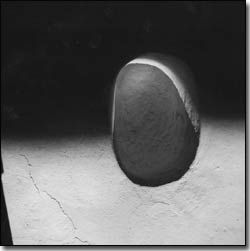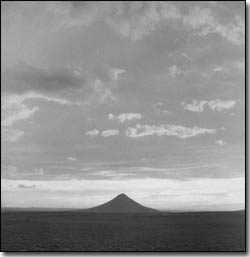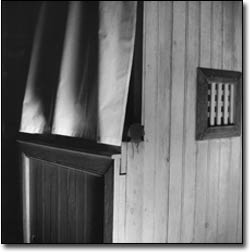|
Author/photographer releases ‘Four
Corners’
by Katie Sands
 |
| Holy Water,” La Trampas, N.M.,
1998, by Debra Bloomfield. |
 |
| “Hopi Mountain,” Hopi,
Ariz., 1991 from Debra Bloomfield’s “Four
Corners. |
 |
“Confessionals,” La
Trampas, N.M., 1998, by
Debra Bloomfield. |
The Four Corners draws its name from the area where the
borders of Utah, Colorado, Arizona and New Mexico meet.
The intersection, though seemingly arbitrary, marks a
territory rich in cultural diversity, spiritual convergence
and one that is threatened by the constant of environmental
deterioration.
In her oversized book, Four Corners, photographer Debra
Bloomfield explores the mystique of the Southwest through
her captivating full color images. Bloomfield, who lives
in Berkeley, Calif., began her Southwestern journey in
1989. Her work in the area eventually brought her to the
desert three or four times a year for 10 years. Marking
each trip on a pocket map, Bloomfield soon realized that
her curiosity and search for desert solitude had led her
in a circle around a single area, the Four Corners.
In the book’s foreword, Bloomfield speaks of the
project’s timeliness. “As I drove from the
Bay Area toward my destination, I was acutely aware of
the transition from dense city sprawl – with its
unique sounds, smells, and visual elements – to
the openness, stillness and subtleties of the desert environment,”
says Bloomfield. “I don’t think I would have
made these photographs the way I did if I had not taken
the time to descend slowly into this landscape.”
Bloomfield’s work sheds new light on well-known
Southwestern treasures like Moab, Utah; Sedona, Ariz.;
Taos, N. M.; and Hovenweep, as well as those lesser-known
ones like Hopiland, Woo Canyon, Las Trampas and Truchas.
Her journey also entailed work in seven different churches.
At Las Trampas, an iconic church of the Four Corners,
and Chimayo, the oldest Catholic church in the United
States, Bloomfield sheds light on the mystical power and
Spanish Catholic influence present in the churches. She
effectively captures images of the Virgin of Guadalupe,
Mother Mary, confessionals and offering boxes, old crutches
left behind after miraculous healings, and the annual
Chimayo Christmas pilgrimage, La Posada. Southwestern
indigenous spirituality is represented through poignant
images of an Arizona medicine wheel and Zuni petroglyphs.
The diversity of Bloomfield’s landscapes reverberates
in striking sunsets, winding river canyons, stunning rock
formations and clusters of storm clouds resting above
desert mesas. Her landscapes prove breathtaking and astonishing
in that she never relies on photographic filters or alters
her images. Such photos affirm the power of nature and
its enduring effects.
Bloomfield is able to capture the full-moon serenity
of White Sands, N. M.; towering formations set in front
of spectacular skies in Chaco, N. M.; and the calm of
desert plains separated by the steep canyons and vein
of the Rio Grande valley. Bloomfieldwork is testament
to her love for that which is dramatic and powerful; she
says that rather than clear blue skies, she prefers dynamic
weather and different light.
Although this California native calls Berkeley home,
Bloomfield expresses a sense of home in her Four Corners
work and says that each piece embodies a deeply personal
element.
“These interior spaces and the landscapes have
similar meaning and significance for me,” she writes.
“They connote a sense of place that resonates with
home, solace, transformation, hope and history. In general,
my work is highly personal in origin. It is often prompted
by a particular concern or question I am exploring in
my own life. This process begins without premeditation,
and often I understand it retrospectively. It is the unanswered
question that gives me endless energy to pursue my work,
a great and all-consuming meditation.”
Hers is a unique perspective, which is able to dissect
and effectively illustrate the Southwest in an appropriate
and deserving way. With a fresh eye behind the lens, her
images succeed in evoking imagination, affirming belief
and tying together all that is significant and embodies
the Southwest.
Four Corners is available for purchase at Maria’s
Bookstore or directly from the University of New Mexico
Press.
|

